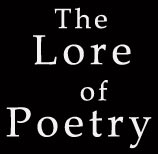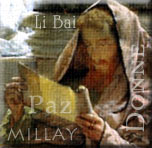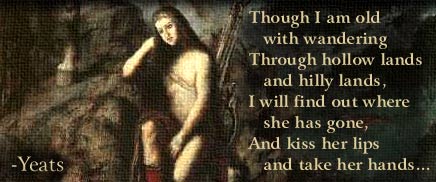William
Butler Yeats (1865-1939)
The
Everlasting Voices
(1899)
O SWEET
everlasting Voices, be still;
Go to the guards of the heavenly fold
And bid them wander obeying your will,
Flame under flame, till Time be no more;
Have you not heard that our hearts are old,
That you call in birds, in wind on the hill,
In shaken boughs, in tide on the shore?
O sweet everlasting Voices, be still.
The
Song of Wandering Aengus
(1899)
I went
out to the hazel wood,
Because a fire was in my head,
And cut and peeled a hazel wand,
And hooked a berry to a thread;
And when white moths were on the wing,
And moth-like stars were flickering out,
I dropped the berry in a stream
And caught a little silver trout.
When I had laid it on the floor
I went to blow the fire aflame,
But something rustled on the floor,
And some one called me by my name:
It had become a glimmering girl
With apple blossom in her hair
Who called me by my name and ran
And faded through the brightening air.
Though I am old with wandering
Through hollow lands and hilly lands,
I will find out where she has gone,
And kiss her lips and take her hands;
And walk among the long dappled grass,
And pluck till time and times are done
The silver apples of the moon,
The golden apples of the sun.
The
Hosting of the Sidhe
(1899)
The host
is riding from Knocknare
And over the grave of Clooth-na-bare;
Caolte tossing his burning hair
And Niamh calling Away, come away:
Empty your heart of its mortal dream.
The winds awaken, the leaves whirl round,
Our cheeks are pale, our hair is unbound,
Our breasts are heaving, our eyes are a-gleam,
Our arms are waving, our lips are apart;
And if any gaze on our rushing band,
We come between him and the deed of his hand,
We come between him and the hope of his heart.
The host is rushing 'twixt night and day,
And where is there hope or deed as fair?
Caolte tossing his burning hair,
And Niamh calling Away, come away.



![]()


